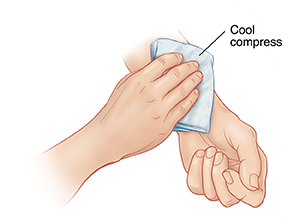A
B
C
D
E
F
G
H
I
J
K
L
M
N
O
P
Q
R
S
T
U
V
W
X
Y
Z
Topic IndexLibrary Index
Click a letter to see a list of conditions beginning with that letter.
Click 'Topic Index' to return to the index for the current topic.
Click 'Library Index' to return to the listing of all topics.
Understanding Cercarial Dermatitis
Cercarial dermatitis is a type of skin rash. The rash is also known as swimmer’s itch. It’s caused by an allergic reaction to tiny parasites. The parasites are sometimes found in water such as lakes, rivers, and the ocean. It can appear minutes to days after swimming in water with the parasites. It usually happens during the summer months. Cercarial dermatitis is not spread from person to person.
How to say it
Sir-KAYR-ee-uhl der-muh-TY-tis
What causes cercarial dermatitis?
The condition is caused by tiny parasites that attach and go into the skin and cause an allergic reaction. A cercaria is a swimming larval stage of a parasite. The parasites are shed into water from the feces of animals such as ducks, seagulls, geese, and snails. The parasites can live in both fresh water and salt water. They can't live or reproduce in your skin. But they can cause an uncomfortable allergic reaction.
Swimmer’s itch is not the same as seabather’s eruption, which is caused by tiny jellyfish larvae. Seabather’s eruption occurs on skin covered by swim clothing that traps jellyfish larvae. Cercarial dermatitis occurs on bare skin not covered by clothing.
Because the cercarial dermatitis rash is an allergic reaction, your body may react more strongly each time you are exposed to the parasites. You may have symptoms quicker, and they may be worse.
Symptoms of cercarial dermatitis
The skin symptoms include:
Treatment for cercarial dermatitis
 |
| A cool, moist compress can help reduce itching. |
The rash will go away in a few weeks to a month. Make sure to prevent infection by not scratching it. You can treat itching with any of these:
-
Cool, moist compress. Put a clean damp cloth on the area for 20 to 30 minutes, 5 to 6 times a day as needed.
-
Corticosteroid cream or ointment. You can apply this medicine several times a day on clean skin.
-
Antihistamine. This medicine can help ease itching. You can put it on your skin as a cream or take it by mouth as a pill.
-
Colloidal oatmeal bath. Soaking in water with colloidal oatmeal can help soothe itchy skin.
-
Baking soda paste. This can help relieve itching. Mix baking soda with water into a paste. Put it on your rash.
-
Other anti-itch lotion or cream. Ask your healthcare provider about other anti-itch lotion or cream that can help relieve itching. They may prescribe a stronger medicine if over-the-counter medicine isn’t helping you.
The best way to prevent getting the rash is to stay out of lakes or bodies of water known to be infested.
Possible complications of cercarial dermatitis
Scratching can cause a bacterial skin infection. An infection may need to be treated with antibiotic medicine. This can be put on the skin as a cream or ointment or taken by mouth as a pill.
When to call your healthcare provider
Call your healthcare provider right away if you have any of these:
-
Fever of 100.4°F (38°C) or higher, or as advised by your healthcare provider
-
Symptoms that don’t get better or get worse
-
New symptoms
Online Medical Reviewer:
Michael Lehrer MD
Online Medical Reviewer:
Raymond Kent Turley BSN MSN RN
Online Medical Reviewer:
Tennille Dozier RN BSN RDMS
Date Last Reviewed:
3/1/2022
© 2000-2025 The StayWell Company, LLC. All rights reserved. This information is not intended as a substitute for professional medical care. Always follow your healthcare professional's instructions.